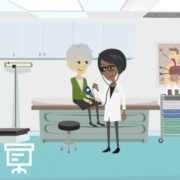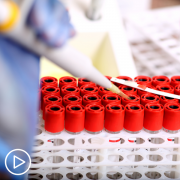Updates from ASH: How Biomarker Testing Has Changed MPN Care
Updates from ASH: How Biomarker Testing Has Changed MPN Care from Patient Empowerment Network on Vimeo.
MPN specialist, Dr. Andrew Kuykendall, discusses how the identification of specific biomarkers in myeloproliferative neoplasms (MPNs), such as the JAK2 mutation, have moved research forward. Dr. Kuykendall shares promising findings that were released at the 2021 American Society of Hematology (ASH) annual meeting and how this may impact MPN care in the future.
Dr. Andrew Kuykendall is an Assistant Member at Moffitt Cancer Center in the Department of Malignant Hematology. Dr. Kuykendall’s clinical and research efforts focus on myeloproliferative neoplasms (MPNs), MDS/MPN overlap syndromes and systemic mastocytosis (SM). Learn more about Dr. Kuykendall, here.
Related Programs

|

Which Gene Mutations Impact Myelofibrosis Treatment Options? |

|
Transcript
Katherine:
How has molecular or biomarker testing changed the field of MPN care and treatment?
Dr. Kuykendall:
Well, I think, first and foremost just understanding – going back to 2005 and knowing that we have JAK2 mutations. I think that gave really a lot of clarity to the diagnosis and really understanding the biology of how the disease acted through the JAK-STAT pathway. And certainly, that led to the understanding of MPL mutations and then calreticulin mutations.
We’re still figuring out exactly how calreticulin mutations work. There was a great abstract, a preclinical abstract, this year talking about the impact of interferon on calreticulin mutations and how that may differ from what we see in the impact of interferon on diseases that are driven by JAK2 mutations.
Clinically, we see a little bit of difference in how those diseases respond and we may understand a little bit better about why that happens. Additionally, that’s kind of gone down to looking at these big next generation sequencing panels where we identify high-risk mutations and that can certainly change our understanding of the prognosis of these diseases.
We’re starting to get, at least in the AML world, we’re getting targeted agents that can potentially target some of these mutations such as IDH1 and IDH2 mutations that have specific inhibitors.
Those are mutations that occur in myeloproliferative neoplasm patients and convey a worse prognosis, so there are ongoing trials looking to see if we can use those IDH inhibitors in myeloproliferative neoplasms either in the chronic phase or maybe in the more accelerated advanced phase.
You know the big thing, this meeting, was actually looking at polycythemia vera patients and what’s the relevance of the JAK2 mutant allele burden. I think this is something we’ve talked about a lot as far as how significant this is. We know in chronic phase myeloproliferative neoplasms that that JAK2 mutation tends to be associated with more thrombotic complications.
There are more blood clots in the veins and the arteries. There were a couple great abstracts that looked at the really the implications of the JAK2 mutation and the fact that it is associated with more thrombosis, but maybe more venous thrombosis. That might be a big risk factor for venous thrombosis and it may be that cardiovascular risk factors, such as diabetes, hyperlipidemia that’s really what’s driving the arteriole thrombosis. It also looked at the variant allele fraction, the number of cells that have that JAK2 mutation.
One abstract showed that if you have over a 50 percent allele fraction, if more than 50 percent of the alleles have the mutation – a higher burden of that mutation that’s associated with an increased thrombotic risk even in low-risk polycythemia vera patients. Whether or not that’s enough evidence to really change the paradigm of how we treat low-risk patients is to be determined, but I think very interesting and provocative work.






























